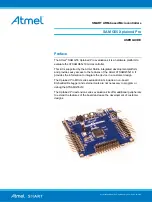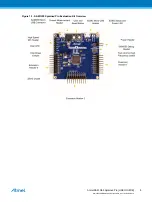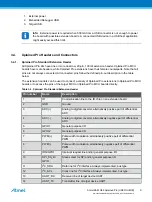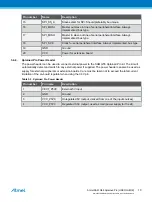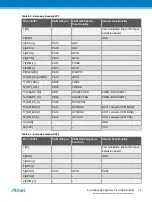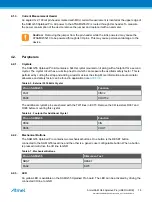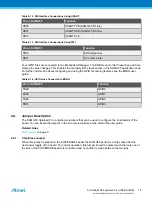
3.
Xplained Pro
Xplained Pro is an evaluation platform that provides the full Atmel microcontroller experience. The
platform consists of a series of Microcontroller (MCU) boards and extension boards, which are integrated
with Atmel Studio, have Atmel Software Framework (ASF) drivers and demo code, support data
streaming, and more. Xplained Pro MCU boards support a wide range of Xplained Pro extension boards,
which are connected through a set of standardized headers and connectors. Each extension board has
an identification (ID) chip to uniquely identify which boards are connected to an Xplained Pro MCU board.
This information is used to present relevant user guides, application notes, datasheets, and example
code through Atmel Studio.
3.1.
Embedded Debugger
The SAM G55 Xplained Pro contains the Atmel Embedded Debugger (EDBG) for on-board debugging.
The EDBG is a composite USB device of three interfaces; a debugger, Virtual COM Port, and a Data
Gateway Interface (DGI).
Together with Atmel Studio, the EDBG debugger interface can program and debug the ATSAMG55J19.
On SAM G55 Xplained Pro, the SWD interface is connected between the EDBG and the ATSAMG55J19.
The Virtual COM Port is connected to a UART on the ATSAMG55J19 and provides an easy way to
communicate with the target application through terminal software. It offers variable baud rate, parity, and
stop bit settings. Note that the settings on the ATSAMG55J19 must match the settings given in the
terminal software.
Info:
The virtual COM port in the EDBG requires the terminal software to set the data terminal
ready (DTR) signal to enable the UART pins connected to the ATSAMG55J19. If the DTR signal
is not enabled the UART pins on the EDBG is kept in high-z (tristate) rendering the COM port
unusable. The DTR signal is set automatically by some terminal software, but it may have to be
manually enabled in your terminal.
The DGI consists of several physical interfaces for communication with the host computer.
Communication over the interfaces is bidirectional. It can be used to send events and values from the
ATSAMG55J19 or as a generic printf-style data channel. Traffic over the interfaces can be timestamped
on the EDBG for more accurate tracing of events. Note that timestamping imposes an overhead that
reduces maximal throughput.
is used to send and receive data through DGI.
The EDBG controls two LEDs on SAM G55 Xplained Pro; a power LED and a status LED. The table
below shows how the LEDs are controlled in different operation modes.
Table 3-1. EDBG LED Control
Operation mode
Power LED
Status LED
Normal operation
Power LED is lit when power is
applied to the board.
Activity indicator, LED flashes
when any communication
happens to the EDBG.
Bootloader mode (idle)
The power LED and the status LED blinks simultaneously.
Bootloader mode (firmware
upgrade)
The power LED and the status LED blinks in an alternating pattern.
Atmel SAM G55 Xplained Pro [USER GUIDE]
Atmel-42389B-SAM-G55-Xplained-Pro_User Guide-04/2016
7

